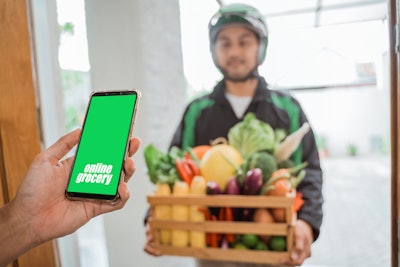
One of the clear outcomes of changing consumer behaviors through the months of COVID-19 this year has been a gravity shift to online grocery shopping. Lockdowns drove many shoppers’ heightened demand for the online channel, but they also drove new, first-time online buyers. And those buyers have kept their nascent online habits.
Recent findings from Nielsen’s global e-commerce syndicated study says that 30% of surveyed shoppers claim to be new to e-commerce this year, with the other 70% saying they shopped online prior to the onset of the pandemic.
As a result, the pool of online buyers continues to grow at a pace much faster than in pre-COVID circumstances. E-commerce measures in the U.S. alone show that new online buyers of fast-moving consumer goods (FMCG) have emerged across all age cohorts, even among those over the age of 65 who represent between 14-24% of new buyers across merchants. Furthermore, repeat purchase rates among new e-commerce buyers in America have been strong. In fact, approximately 50-60% of U.S. shoppers who made their first e-commerce purchase between March and October this year have already made a repeat purchase within the online channel.
Earlier this year, the Nielsen Intelligence Unit identified four emerging patterns that helped predict the drivers of pandemic purchase decisions: a basket reset, a homebody reset, a rationale re-set and an affordability reset. Each of these re-set patterns have huge implications when applied to the lens of today’s online shoppers.
E-commerce basket re-set
The pandemic has broadened shoppers’ e-commerce repertoire for many everyday essentials. But measures of shopper sentiment across countries can help to predict which categories will be priorities for purchase retention in 2021.
Across multiple countries, shoppers indicate that COVID-19 was a catalyst to them beginning to purchase various essentials online. Interestingly, the data suggests that pandemic-driven demand for certain categories online may be correlated to relative maturity and local adoption of e-commerce in a given market. In other words, where e-commerce infrastructure is less robust or perhaps less trusted, COVID-19 factors haven’t yet pushed online shoppers to purchase categories such as fresh foods, where the burden of trust is quite high.
In South Korea, for example, where e-commerce market maturity is relatively high compared to the rest of the world, shoppers are buying consumable products that require a greater degree of trust in the company picking and providing the end goods. Here, nearly a third of shoppers (32%) have begun to purchase packaged groceries online because of the pandemic, and 21% say they’ve done so for fresh groceries as well.
Meanwhile, in some markets where e-commerce is still maturing, we see categories aligned to self-care become more of a digital affair. In India, where e-commerce is swiftly growing, but where traditional trade channels remain prolific, 43% of urban Indian online shoppers say they purchase hair and body care products via e-commerce due to COVID-19. And in Italy, more than two in 10 surveyed shoppers now purchase fashion, hair and body care products online because of COVID-19 conditions.
Digital homebody re-set
The good news for marketers is that trust can scale very quickly in an online environment, particularly since e-commerce has proven to be such a necessity to homebound consumers.
E-commerce represents a lifeline to many consumers who’ve chosen to minimize physical retail shopping this year. Because of this, there’s a heightened opportunity to engage with categories like fresh foods that have historically been harder to sell online.
Trust has long been a major barrier to e-commerce adoption. In fact, many of the top reasons why surveyed shoppers globally don’t consider purchasing online relate to a lack of trust in product quality (26%) or concerns about product expiration (29%). But when trust can be earned, it can encourage and build the shopping basket across a multitude of categories.
For example, 50% of surveyed shoppers across markets say they are more likely to purchase groceries from online retailers that offer fresh food products. Getting it right with fresh foods sold online could translate into bigger baskets that include other grocery and non-food items.
Lauren Fernandes, Director of Nielsen’s Intelligence Unit, says that “particularly with the conditions of COVID-19, many physical retail experiences such as self-serve prepared food stations have been shifted out of the safe and desirable spotlight.” She continues “There’s an opportunity to infuse trust and credibility into e-commerce, whether that be through tactical features of the payment process or through experiential elements that can enlighten shoppers on their product’s origin or journey. It could be as simple as information on how safely their products are packaged or what local establishment may be supported through their purchase.”
Currently, one in three global surveyed shoppers claim to purchase fresh food and beverages exclusively online. Growing this number, while maintaining trust, will translate into e-commerce opportunities beyond consumables—and potentially across the virtual store.
Online rationale re-set
The swift pace of e-commerce adoption this year has heightened e-tail competition and encouraged disloyalty among consumers. Marketing tactics and investments should reflect this shifted shopper mindset.
Online shoppers are playing the field when it comes to the virtual storefronts they purchase from. Therefore, online brands and e-tailers shouldn’t focus efforts on holding or growing loyalty without a clear benefit proposal.
Across surveyed markets, the average online shopper has ordered from approximately four different e-tailers in the past three months. In Asian markets, this number has been even higher, with online shoppers claiming to have spread their purchases across as many as five e-tailers in China and six e-tailers in Korea.
Online brands should embrace this disloyalty and strive to create touchpoints that boost top-of-mind awareness and brand equity.
E-tail affordability re-set
Price matters, but there are a number of other key factors that shoppers consider imperative to their e-commerce decision making. Complement your price strategy with the right mix of unique selling propositions online.
Price was one of the top reasons why shoppers have switched between different e-tailers, however, it was not the only top reason. Across surveyed markets, shoppers were equally likely to switch between e-tailers if products were more expensive (47%), if delivery costs have increased (47%) or if products were proven faulty (47%) or fake (46%). What this shows is that price doesn’t need to be a sole differentiator to an e-commerce offering.
Nielsen research highlights key areas, beyond price, that contribute to the affordability reset guiding future e-commerce shopping decisions. While it might seem obvious, shoppers continue to indicate they want and need e-tailers to “make it easy” for them. For more than 50% of surveyed shoppers, ease of payment and free delivery are highly influential, driving many shoppers to decide to complete their purchases online.
Community input also matters and can help assert value and build trust when it comes to justifying a product’s price point. An overwhelming majority (74%) of shoppers indicate that reviews are important when considering whether or not to buy something, and seven in 10 shoppers say they prefer online retailers that have product reviews.
And when it comes to offering promotions, aside from price cuts, one of the top-preferred means for online promotion is offering product bundles. This emphasizes the role of assortment. In fact, offering the right product portfolio continues to be critical, as 63% choose to shop online seeking a wide selection of brands and products.
Across the broad spectrum of FMCG e-commerce, new online shoppers continue to make repeat purchases, and existing buyers are expanding their online purchase repertoires. Companies seeking to maintain and grow their online presence into 2021 and beyond will need to understand these new behavioral patterns and exploit the opportunities to benefit from long-term e-commerce adoption.



















